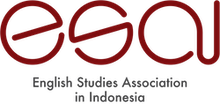The Elements of Multiculturalism in Dwilogi “Angin dari Tebing” by Clara Ng.
Abstract
This study discusses the values of multiculturalism contained in the dwilogi of "Angin Dari Tebing" by Clara Ng. This research aims to reveal the multiculturalism elements in Clara NG's dwilogi of “Angin Dari Tebing”. This research is based on the value theory of multiculturalism which Thobroni and Nurgiyantoro coined. The values of multiculturalism in the text are analyzed using Barthes' semiotic theory of connotation and denotation. The results of this study state that there are five values of multiculturalism contained in this dwillogi of children's stories: solidarity and brotherhood, gender equality, family values, a sense of contentment in life, and sharing and control of power. Of the five values, the values of solidarity and brotherhood are described more by Clara. Each character with a different background has a high sense of tolerance and empathy so that no ethnocentrism can damage or negatively influence child readers. This study concludes that this book can be used as good reading material for children with good multiculturalism values. This book can teach about the importance of tolerance and mutual respect despite being in an environment with differences in race, ethnicity, religion, and language, as in Indonesia.
Downloads
References
Barthes, R. (2016). Elemen-Elemen Semiologi. Jalasutra.
Djumala, R. (2017). Multikulturalisme dalam Bacaan Anak Indonesia. Proceedings The 5th Literary Studies Conference “Textual Mobilities: Diaspora, Migration, Transnationalism and Multicultural., 119–123.
Fadilah, S. (2018). Kesetaraan gender : Fenomena pergeseran peran ekonomi wanita dari tulang rusuk menjadi tulang punggung. Gender Dan Anak, 1(1), 18–26.
Fitriana, A., & Cenni. (2021). Perempuan Dan Kepemimpinan. Prosiding Webinar Nasional IAHN-TP Palangka Raya, 247–256.
Ilaa, D. T. (2021). Feminisme dan Kebebasan Perempuan Indonesia dalam Filosofi. Jurnal Filsafat Indonesia, 4(3), 2011–2016.
Junanto, S., & Fajrin, L. P. (2020). Internalisasi Pendidikan Multikulturalisme Pada Anak Usia Dini. Jurnal Pendidikan Anak Usia Dini, 8, 28–34.
Khotibi, D. (2020). PENAFSIRAN ZAITUNAH SUBHAN DAN AMINAH WADUD TENTANG KEBEBASAN PEREMPUAN. Mushaf: Jurnal Tafsir Berwawasan Keindonesiaan, 1(109–144).
Lamanna, M. A., & Riedmann, A. (2009). Marriages & Families: Making Choices in A Diverse Society. Thomson Wadsworth.
Lestari, E. (2017). Representasi Multikultural Dalam Novel Burung-Burung Rantau Karya Y.B Mangunwijaya Sebagai Sarana Pendidikan Karakter Bangsa Berbasis Budaya Siswa SMA. Prosiding SENASGABUD, 53–63.
Moleong, L. . (2007). Metodologi Penelitian Kualitatif. Remaja Rosdakarya.
Musi, M. A., & Parwoto. (2019). Pembelajaran Multikultural Anak Usia Dini Berbasis Kearifan Lokal. Prosiding Seminar Nasional LP2M UNM, 693–701.
Novita, R. (2012). MULTIKULTURALISME DALAM NOVEL PELANGI MELBOURNE: DUA DUNIA SATU CINTA KARYA ZUHAIRI MISRAWI. Jurnal Pendidikan Bahasa Dan Sastra Indonesia, 1, 426–514.
Puspita, W. A. (2013). Multikulturalisme dalam Pendidikan Anak Usia Dini. Jurnal Ilmiah VISI P2TK PAUDNI, 9, 144–152.
Ratna, N. K. (2012). Teori, Metode, dan Teknik Penelitian Sastra. Pustaka Pelajar.
Suparlan, P. (2002). Multikulturalisme. Jurnal Ketahanan Nasional, 7, 9–18.
Thobroni, M., & Nurgiyantoro, B. (2010). Multikulturalisme dalam Cerita Tradisional Yogyakarta. Jurnal Penelitian Humaniora, 11, 154–169.
Copyright (c) 2022 Anaphora: Journal of Language, Literary, and Cultural Studies

This work is licensed under a Creative Commons Attribution-ShareAlike 4.0 International License.
Authors whose manuscript is published will approve the following provisions:
-
The right to publication of all journal material published on the jurnal anaphora website is held by the editorial board with the author's knowledge (moral rights remain the property of the author).
-
The formal legal provisions for access to digital articles of this electronic journal are subject to the terms of the Creative Commons Attribution-ShareAlike (CC BY-SA) license, which means Jurnal Persona reserves the right to store, modify the format, administer in database, maintain and publish articles without requesting permission from the Author as long as it keeps the Author's name as the owner of Copyright.
-
Printed and electronic published manuscripts are open access for educational, research and library purposes. In addition to these objectives, the editorial board shall not be liable for violations of copyright law.




